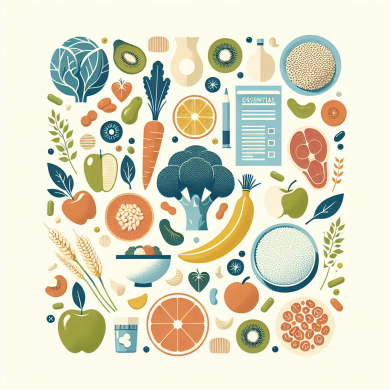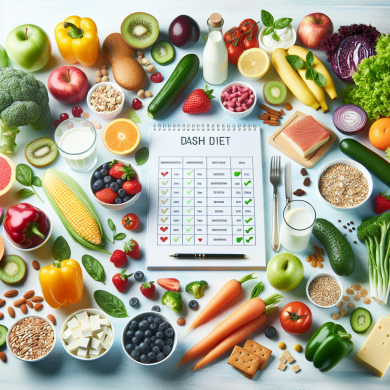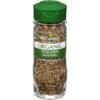Unlock Heart Health: DASH Diet Benefits
Introduction
Heart health is a vital aspect of overall well-being, yet cardiovascular diseases remain one of the leading causes of death globally. The Dietary Approaches to Stop Hypertension (DASH) diet has emerged as a powerful ally in the fight against heart disease. This diet, originally developed to lower blood pressure, has shown a multitude of benefits for heart health and general wellness. In this article, we will explore the DASH diet, its benefits, and how it can be effectively incorporated into your lifestyle to unlock optimal heart health.
Understanding the DASH Diet
The DASH diet is an evidence-based eating plan that emphasizes the consumption of whole foods, primarily focusing on fruits, vegetables, whole grains, lean proteins, and low-fat dairy products. It is low in sodium, cholesterol, and saturated fats, while rich in nutrients such as potassium, calcium, magnesium, and fiber. The primary aim of the DASH diet is to prevent and manage hypertension, but its benefits extend far beyond blood pressure regulation.
The Core Components of the DASH Diet
Fruits and Vegetables
Fruits and vegetables are the cornerstone of the DASH diet. They are packed with essential vitamins, minerals, and antioxidants that contribute significantly to reducing cardiovascular risk. A diet rich in these food groups can help lower blood pressure, reduce inflammation, and improve cholesterol levels.
Whole Grains
Whole grains such as brown rice, quinoa, and whole wheat bread are preferable over refined grains in the DASH diet. They provide fiber, which aids in digestion and helps manage cholesterol levels, thereby promoting heart health.
Lean Proteins
The DASH diet encourages the consumption of lean protein sources like poultry, fish, beans, and nuts. These proteins are vital for muscle maintenance and repair and are lower in unhealthy fats compared to red meats.
Low-Fat Dairy
Low-fat or fat-free dairy products are excellent sources of calcium and vitamin D, which are crucial for heart health. These products also help in maintaining healthy blood pressure levels.
Nuts, Seeds, and Legumes
Nuts, seeds, and legumes provide healthy fats, protein, and fiber, contributing to a feeling of fullness and satiety. They are also beneficial in lowering bad cholesterol and improving heart health.
Reduced Sodium Intake
The DASH diet limits sodium intake to 2,300 milligrams per day, with an ideal target of 1,500 milligrams for individuals with hypertension. Lowering sodium intake helps manage blood pressure and reduces the risk of heart disease.
Benefits of the DASH Diet for Heart Health
Lowers Blood Pressure
The DASH diet is renowned for its ability to lower blood pressure. By emphasizing foods high in potassium, magnesium, and calcium, the diet helps balance the body’s electrolyte levels, reducing blood pressure effectively. Studies have demonstrated significant reductions in both systolic and diastolic blood pressure among individuals following the DASH diet.
Reduces Cholesterol Levels
High levels of LDL (bad) cholesterol are a significant risk factor for heart disease. The DASH diet’s focus on whole foods, fiber-rich grains, and healthy fats can help lower LDL cholesterol levels while maintaining or increasing HDL (good) cholesterol levels. This balance is crucial for optimal heart health.
Promotes Weight Loss
Obesity is a known risk factor for cardiovascular disease. The DASH diet promotes weight loss by encouraging the consumption of nutrient-dense, low-calorie foods. By prioritizing whole foods and reducing processed foods, individuals can achieve and maintain a healthy weight, further reducing their risk of heart disease.
Improves Insulin Sensitivity
Insulin resistance is closely linked to obesity and heart disease. The DASH diet’s emphasis on whole grains, lean proteins, and healthy fats improves insulin sensitivity, helping to regulate blood sugar levels and reduce the risk of type 2 diabetes, a major contributor to heart disease.
Reduces Inflammation
Chronic inflammation is a contributing factor to the development of heart disease. The antioxidants and phytochemicals found in fruits, vegetables, and whole grains help combat inflammation, thus protecting the heart from damage.
Incorporating the DASH Diet into Your Lifestyle
Start Gradually
Transitioning to the DASH diet doesn’t have to be overwhelming. Start by incorporating more fruits, vegetables, and whole grains into your meals. Gradually replace processed foods with healthier options.
Plan Your Meals
Meal planning is key to successfully adopting the DASH diet. Plan balanced meals that include a variety of food groups. This will help you stay on track and reduce the temptation to reach for unhealthy snacks.
Read Labels
Understanding food labels is crucial when following the DASH diet. Look for products low in sodium, saturated fats, and added sugars. Opt for foods rich in nutrients that support heart health.
Be Mindful of Portion Sizes
Portion control is essential in maintaining a healthy weight and preventing overeating. Be mindful of serving sizes and listen to your body’s hunger cues.
Stay Consistent
Consistency is key to reaping the full benefits of the DASH diet. Make it a lifestyle rather than a temporary change. With time, you will notice significant improvements in your heart health and overall well-being.
Conclusion
The DASH diet is a well-researched, effective approach to improving heart health. By prioritizing whole foods and reducing the intake of sodium, unhealthy fats, and processed items, individuals can significantly lower their risk of heart disease. The benefits of the DASH diet extend beyond heart health, promoting weight loss, improved insulin sensitivity, and reduced inflammation. By incorporating the principles of the DASH diet into your lifestyle, you can unlock optimal heart health and enhance your overall quality of life.















Add comment